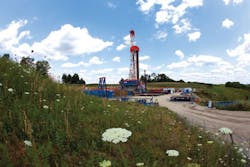Environmental hurdles threaten to stymie US shale production
Photo courtesy of Range Resources
Matthew J. Armstrong and Jason B. Hutt, Bracewell & Giuliani LLP, Washington, DC
Industry spectators assumed, given the announced priorities of the new Obama Administration and the 2006 change in control of Congress, that federal policymakers would renew attention on regulating the ever-growing domestic natural gas industry. However, several other developments over the last year—emerging grassroots resistance to expanded onshore drilling, concerns over air quality issues, increasing consolidation in the industry and the reintroduction of the FRAC Act—have sharpened and added urgency to the debate, and have increased the likelihood of federal regulation of certain aspects of the industry.
Hydraulic fracturing: focal points of concern
To the extent that one issue has seized the imagination of the press and public, that issue is hydraulic fracturing. Hydraulic fracturing, or "fracing," a well-known and long-used technology within the industry, has gained national attention only recently due to the ubiquity of the practice in new shale gas drilling. Easy to demagogue, hydraulic fracturing has become a whipping post for opponents of increased domestic shale gas production.
Award-winning documentaries, mainstream press coverage and editorials, ranting blog posts, posturing politicians, local calls for moratoriums, grassroots protests—it's all there, and it increases daily, with little acknowledgement of the relative strengths of natural gas vis-à-vis other energy sources or the fact that no method of energy production has zero risk or zero environmental impact. Indeed, in this last regard it remains unclear whether domestic shale gas drilling will benefit from the Deepwater Horizon disaster or will be lumped in with offshore drilling as the impact of that event begins to shape public policy moving forward.
The National Resources Defense Council, Earthworks, the Environmental Working Group, and others have collected various anecdotal stories from Wyoming, Colorado, Ohio, and Pennsylvania in post-2004 reports that purport to connect fracing to groundwater contamination. Many of these accounts conflate risks inherent to oil and gas extraction and distribution generally with the alleged risks from hydraulic fracturing specifically. This obscures the fact that no one has scientifically demonstrated any link between any groundwater contamination and the migration of fracing fluids injected into geologic formations several thousand feet below the groundwater resource that these organizations are concerned about.
Nonetheless, even the assertion of a nexus is sufficient to create a political imperative to act in places like New York, where the largest major metropolitan area (New York City) draws its water, untreated, from basins within the Marcellus shale play. Fears surrounding the risk of groundwater contamination have halted expansion of shale gas drilling in that state, where a moratorium has been put in place pending study of the environmental impacts of shale drilling by the state environmental agency. At a standstill now for two years, the process shows no real end in 2010. Resolutions yielding similar moratoriums on the practice have been passed in certain municipalities in Pennsylvania, Colorado, New Mexico, and Texas, but without effect given the preemptive nature of state oil and gas regulation.
Hydraulic fracturing has not historically been treated as a point of regulation separate and apart from the general regulation of downhole activities, which is to say, it has primarily been regulated under the auspices of state oil and gas regulations regarding casing, cementing, and water and waste management that are applicable to all drilling and well completion activities. Congress specifically exempted hydraulic fracturing from regulation under the Underground Injection Control (UIC) program in the Safe Drinking Water Act (SDWA) in 2005. This exemption followed several years of EPA study of the potential impacts of hydraulic fracturing in coalbed methane (CBM) formations on underground sources of drinking water. During the study, the EPA voiced some concern about the use of diesel-containing fracing fluid in coalbed methane formations in proximity to drinking water.
In order to resolve the EPA's concern (but without sharing it), three hydraulic fracturing companies entered into a voluntary agreement with the agency under which they agreed to cease using diesel-containing fracing fluid in CBM formations in underground sources of drinking water. Several months after the MOA was signed, the EPA released its study, which found that hydraulic fracturing posed "little or no threat" to drinking water.
The credibility of the MOA has been undermined by well-publicized revelations from Rep. Henry Waxman (D-CA) that two of the signatories continued to use diesel-containing fracing fluid after signing the agreement, though it remains unclear whether such use was in violation of the MOA. This prompted Rep. Waxman to issue new letters of inquiry to eight major US fracing companies in February 2010, requesting broad swaths of information regarding the chemical constituents of and total volumes used of the companies' fracing fluids, where their operations are conducted, how much wastewater is generated, and how it is disposed of. This investigation may lead to congressional hearings on hydraulic fracturing sometime this year.
In turn, the investigation has injected new life into the so-called "FRAC Act," companion bills introduced in 2009 in the US House of Representatives and in the Senate that would overturn the exemption for hydraulic fracturing contained in the SDWA. Previous iterations of the FRAC Act have died in committee after being introduced. Now, many believe there is a realistic possibility that the current proposed legislation could be included in any energy bill to come out of the House.
The FRAC Act would modify the definition of "underground injection" in the SDWA UIC program specifically to include hydraulic fracturing, overturning the exemption and removing the EPA's discretion not to regulate the practice. In addition, the FRAC Act would impose an affirmative obligation on well operators to disclose fracing fluid constituents to the applicable regulatory agency, which would then be obligated to make that list available to the public. This has prompted concern regarding the treatment of proprietary fracing formulas. The level of disclosure that would be required under the FRAC Act is not evident from the bill's language.
There is some reason to believe that the EPA's new study of hydraulic fracturing, announced in March 2010, may forestall federal legislation until the agency's results are published, which, based on initial scoping documents for the proposed study, could take two years or more. In the meantime, the EPA continues to assess whether it will expand its community right-to-know regulations to require chemical inventory and reporting obligations for well operators.
This potential federal regulation is largely duplicative of state efforts to address their residents' specific concerns about hydraulic fracturing. Colorado, Wyoming, and West Virginia all require operators to identify fracing fluids in their permit applications. Water use and wastewater disposal are key concerns in many states, and permitting requirements are changing to reflect that. Pennsylvania is also considering rather stringent surface discharge rules that may impact how wastewater is treated and disposed of. The marginal cost of these state regulations is unknown; federal regulation will only add more.
Air quality: a local problem?
In Texas, opposition has grown largely in hand with questions regarding the impact of drilling on air quality. In January 2010, the Texas Commission on Environmental Quality (TCEQ) released the results of an air quality monitoring survey in the Barnett shale. Out of 94 monitoring sites spread over 5,000 square miles and six counties, TCEQ detected benzene levels at only two sites in excess of the TCEQ's short-term health-based comparison value. These detections were attributed to one-off issues such as leaking valves not indicative of the overall emissions profile of the oil and gas exploration activities. At another 19 sites, the TCEQ expressed concern about long-term cumulative exposure. At the majority of monitoring sites, chemicals were either not detected or detected below levels of immediate concern.
Concerns over benzene levels associated with drilling have prompted the City of Fort Worth to fund its own air quality study, at which time the Fort Worth City Council indicated it intends to revise its natural gas drilling ordinance after it obtains the results of a city-funded air quality study. Similarly, in response to the TCEQ's study, the City of Dish enacted a moratorium on new drilling permits pending further action by the TCEQ on benzene emissions from drilling and related gas infrastructure (the allegedly elevated benzene levels found in Dish, for example, were actually attributed to a large battery of compressor stations servicing regional pipelines).
The TCEQ recently established two monitoring stations near Dish that stream air quality information directly to the public online. At least two other cities, Mansfield and Kennedale, are examining whether to require drillers to establish baseline ambient air quality at new drilling sites before drilling, and then to provide periodic follow-up air sampling data to the cities during operation.
An open question remains whether this issue is uniquely tied to the Barnett shale or will become a new battle line for shale gas drilling in other plays. The mayor of Dish has embarked periodically on publicity tours in the Northeast, meeting with municipal and environmental groups interested in opposing further shale gas drilling. But it is becoming increasingly clear that downhole activity is not the only potential target for regulatory action.
Greenhouse gas emissions: a developing critique
One of the main arguments in favor of a light regulatory touch is the expectation that natural gas will serve as a bridge to a low-carbon economy. Proponents assert that natural gas will not only replace coal as the fuel for baseload energy production (and possibly replace petroleum for transportation fuel), but because natural gas is abundant domestically, low prices could cushion the shock of the transition by reducing the price for all energy sources in the portfolio, reducing the ultimate cost of a low-carbon policy itself.
While this narrative is still largely taken for granted among policymakers as a fundamental reason to support natural gas development, environmental advocacy groups have begun testing the notion that natural gas even provides any greenhouse gas reduction over coal at all. These efforts have recently received some support from a draft paper circulated by Robert Howarth of Cornell University in mid-March 2010. The paper, entitled Preliminary Assessment of the Greenhouse Gas Emissions from Natural Gas Obtained by Hydraulic Fracturing, concludes that a "rough" lifecycle analysis of natural gas produced from shale reveals greenhouse gas emissions that exceed those from a similar analysis of coal, diesel fuel or gasoline. Howarth's rough calculations depend on an assumption that methane leaks during drilling, transportation and storage of natural gas in an amount equivalent to 1.5% of all natural gas consumed, derived from 2006 data from the US Department of Energy.
This paper, while picked up by Reuters and several environmental advocacy groups, has not created the sort of stir one would expect. It may be a mistake, however, to discount the probability of this becoming a theme in criticisms of domestic gas production going forward. Indeed, the paper is cited (and attached) to several public comments submitted on the scope of the EPA's new fracing study. Data reported by the natural gas sector under the EPA's newly proposed Subpart W greenhouse gas emission reporting is likely to be closely watched for this reason.
Market implications of increased regulation: domestic versus international growth
The hydraulic fracturing debate has been a difficult one to address at the national level. Drilling has intensely local impacts and different regions have had different concerns. But while these concerns may vary regionally, environmental groups and some legislators have collected them into a coherent, comprehensive criticism of domestic unconventional gas drilling operations. This could have ramifications not only to shale gas production in the US, but internationally as well.
While shale gas currently comprises a small percentage of actual global natural gas reserves, some credible estimates indicate that shale gas provides more than 50% of global unconventional natural gas potential, or more than 15,000 tcf. Outside the United States, China sits on the largest untapped shale gas potential globally. Significant potential exists in Latin America, Africa, the Middle East, Europe/Eurasia, and Australia.
It is no mystery, therefore, why the multinational majors are increasing their positions in the shale gas market. Much of the press coverage of the December 2009 announcement of the $41 billion ExxonMobil-XTO Energy merger focused on what it meant for domestic shale gas production, but when ExxonMobil CEO Rex Tillerson was probed in congressional hearings about ExxonMobil's motivation for the merger, he ascribed it largely to the desire to export XTO's technology and expertise to ExxonMobil's international unconventional gas plays.
Increasing consolidation, while to some extent a hangover from the boom years in the mid-2000s, represents the first step in increased global shale gas production. South Africa's Sasol Petroleum International recently announced a joint venture with Chesapeake Energy and Statoil ASA to explore shale gas resources in South Africa's Karoo Basin. In March 2010, Total acquired Devon Energy's French affiliate and immediately commenced shale gas exploration in that country. Baker Hughes, an international well services company, closed its merger with one of the largest fracing companies in the US, BJ Services, in late April.
The implications of all of these developments on domestic shale gas production are obvious: in the worst case scenario, shale gas drilling is prohibited or made uneconomical by increased regulations. Significant capital investment in infrastructure is necessary to develop domestic shale resources fully, with billions needed to construct midstream transmission pipelines alone.
Some industry watchers have observed that shifts in natural gas supply sources rather than an increase in consumption will be the main driver of midstream investment. While regulation may not render domestic shale gas drilling uneconomical right now, attention is warranted to whether additional regulations without actual environmental benefits will raise costs to a point that the balance of shale gas exploration and development moves overseas.
About the authors
Matthew J. Armstrong is an associate and Jason B. Hutt is a partner in Bracewell & Giuliani's Environmental Strategies Group based in Washington, DC, which advises clients on natural gas resource development issues, including hydraulic fracturing, water use, water disposal, and air permitting.
More Oil & Gas Financial Journal Current Issue Articles
More Oil & Gas Financial Journal Archives Issue Articles
View Oil and Gas Articles on PennEnergy.com



